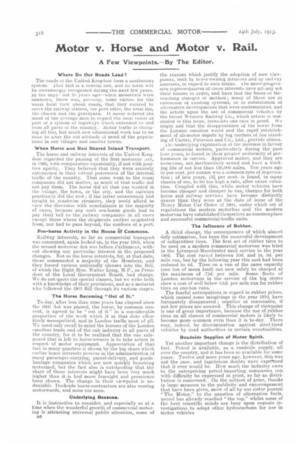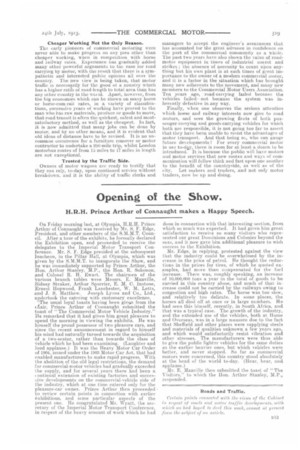Motor v. Horse and Motor v. Rail.
Page 2

Page 3

If you've noticed an error in this article please click here to report it so we can fix it.
A Few Viewpoints.—By The Editor.
Where Do Our Roads Lead ?
The roads of the United .Kingdom form a continuous system. That tact is a centiliti one, and its ioree will be increasingly recognized during the next few years. In tile days— not 20 years ago—when motorcars were unknown, there was, poesany, some excuse for the usual local view about roads, that they existed to serve the railway station, the pose (Alice, the local mu, the church and the graveyard. It never entered the mind of tee average man to regard the local roaas as part of a system of hignways which extended to and ;rum all parts ot the country. Motor traffic is cluinglug all this, but much new educational work has to be done to alter the old attitude of mind of the populations in our villages and smaller towns.
When Horse and Rail Shared Inland Transport.
The horse and railway interests of the United Kingdom regarded the passing of the first motorcar _act, in 1896, with comparative equanimity, if not with positive apathy. They believed that they were securely entrenched in their virtual possession of the internal traffic of the country. That some went to the canal companies did not matter, as much of that traffic did not pay them. The horse did all that was wanted in the village, the town, or the city, and the railways practically did the rest ; if the latter occasionally lost freight to coastwise steamers, they could afford to view the diversion with nonchalance in the majority of cases, because any such sea-borne goods had to pay their toll to the railway companies in all eases except those where the shipments neither originated from, nor had to pass beyond, the confines of a port.
Pro-horse Activity in the House Of Commons.
Railway interests, so far as commercial transport was concerned, again looked on, in the year 1903, when the second motorcar Act was before Parliament, without showing any particular interest in the proposed changes. Not so the horse interests, for, at that date, these commanded a majority of the Members, and they forced various unfriendly clauses into the Bill, of which the Right Hon. Walter Long, M.P., as President of the Local Government Board, had charge. We do not quote the special clauses, but we write both with a knowledge of their provisions, and as a motorist ho followed the 1903 Bill through its vasiene stages.
Th. Horse Becoming "Out of It."
To-day, after le.es than nine years has elapsed since the 1903 Act was passed, the horse, by common consent, is agreed to be "out of it" in a considerable proportion of the work which it at that date effectively monopolized, and in London tsaffic most of all. We need only recall to mind the lessons of the London omnibus trade and of the cab industry in all parts of the country, for it to be realized that the one safeguard that is left to horse-owners is to take action in respect of motor equipment. Appreciation of that fact in many quarters is shown by the big share which earl ie,r horse interests possess in the administration of niauy passenger-carrying, parcel-delivery, and goodshaulage companies which are now quickly becoming motorized, hut the fact also is outstanding that the share of those interests might have been very much higher than it is had more fosesight and prescience been shown. The change in their viewpoint is undeniable. Dockside horse-contractors are also veering motorwards, and none too soon.
Underlying Reasons.
It is instructive to consider, and especially so at a time is the wonderful growth of commercial motoring s attracting universal public attention, some of n8
the reasons which justify the adoption of new viewpoints, both be horee-owniug interests and by railway interests, in regard to sues trastic. ihe more-progressive representaieves of those interests have atrcady set their houses in order, and have laid the bases of farreaching changes ot method ; many ot these are in extension 0/ existing systems, or in substitution of alternative developments that were contemplated, and the article upon the use of commercial vehicles by the tercet Western Railway Co., which article is concluded in this issue, lurnishes one case in point. W might add that the disappearance of the horse front the London omnibus world and the rapid establishment of all-motor depots by big carriers of Zne standing of Carter, Paterson and Co., Ltd., provide others.
lire underlyingexplanation of the increase in favour of commercial motors, particularly during the past four years, is found in their greater uniformity of performance in service. Approved makes, and they are numerous, are mechanically eound and have a working life of not less than 1511,000 miles. Ten years ago 30 per cent, per annum was a common rate of depreciation ; of late years, 12A per cent, is found, in many classes of use, to be too high a rate, after exact valuation. Coupled with this, while motor vehicles have become cheaper and cheaper to run, charges for both horse and railway services have become distinctly dearer than they were at the date of issue of the Heavy Motor Car Order of 1904, under which set of regulations the modern motorbus and the modern motorvan have established themselves as commonplace and successful commercial-traffic units.
The Influence of Rubber.
A third change, the consequences of which almost defy estimation, has been the successful development of indiarubber tires. The first set of rubber tires to be used on a modern commercial motorva,n was tried in the Liverpool-Manchester mail service in the year 1902. The cost varied between 10d. and is. Bd. per mile run, but by the following year this cost had been reduced to 4d. Tires on a van of the same capacity (one ton of mean load) can now safely be charged at the maximum of .75d. per mile. Some fleets of London motorvans in the service of the big stores show a cost of well below i15d. per mile run for rubber tires on one-ton vans.
The fearful anticipations in regard to rubber prices, which caused some misgivings in the year 1910, have .fortunately disappeared ; supplies at reasonable, if not low prices are assured. This change of viewpoint is one of great importance, because the use of rubber tires on all classes of commercial motors is likely to become more common even than it is to-day. There may, indeed, he discrimination against steel-tired vehicles by road authorities in certain eventualities.
Roadside Supplies of Motor Spirit.
Yet another important change is the distribution of fuel. Petrol is available, as a roadside supply, all over the country, and it has been so available for some years. Twelve and more years ago, however, this was not the case, and lugubrious doubts were exprrssed that it ever would be. How much the inchistry owes to the enterprising petrol-importing companies can with difficulty be expressed in print, so far as distribution is concerned. On the subject of price, thanks in large measure to the publicity and encouragement that have been given, most of all by our sister journal "The Motor," to the question of alternative fuels, petrol has already reached "the top," whilst some of the best scientific minds are busy upon cognate investigations to adapt other hydrocarbons for use in motor vehicles Cheaper Working Not the Only Re&SOD.
The early pioneers of commercial motoring were never able to _make progress on any plea other than cheaper working, when in competition with horse and railway rates. Experience has gradually added many other powerful arguments to tin; case for road carrying by motor, with the result that there is a sympathetic and interested public opinion all over the country. The new view is being taken, that motor traffic is necessarily for the good of a country which has a higher redo of road-length to total area inan has any other country in the world. Apart., however, front the big economies which can be shown on many horse or horse-cum-rail rates, in a variety of classifications, successive years of working have proved to the man who has raw materials, produce or goods to move, that road transit is of ten the quickest, safest and mostsatiefactory method, as well as the cheapest. In fact, it is now admitted that many jobs can he done by motor, and by no other means and it is evident that old ideas of distance have to be revised. It is no uncommon -occurrence for a furniture remover or motor contractor to undertake a 200-mi1e trip, whilst London motorbus routes of from le miles to 17 miles in length are not exceptional.
Trusted by the Traffic Side.
Owners of motor wagons are ready to testify that they can rely, to-day, upon continued service without breakdown, and it is the ability of traffic clerks and managers to accept the engineer's assurances that has accounted for the great advance in confidence on the part of the commercial community as a whole. The past two years have also shown the value of roadmotor equipment in times of industrial uriaest and strikes ; the absence of necessity to count upon anything but his own plant is at such times of great importance to the owner of a modern commercial mnotor, and it is is factor in the situation, which has brought many new adherents to the movement, and many new members to the Commercial Motor Users Association. Ten years ago, road-carrying faded because the vehicles failed---not because the system was inherently defective in any way.
Finally, when one observes the serious attention which horse and railway interests now give to road motors, and sees the growing fleets of both passenger-carrying and goods-carrying vehicles for which both are responsible, it is not going too far to assert that they have been unable to resist the advantages of motor transport. And that being so, who earn gauge future developments I For every commercial motor in use to-ddy, there is room for at least a dozen to be introduced. It is because the public will have motors and motor services that new routes and ways of communication will follow thick and fast upon one another to the benefit of the countryside, as well as of the city. Let makers and traders, and not only motor traders, now be up and doing.








































































